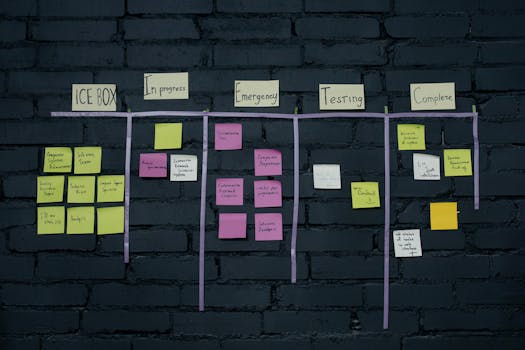Risk Management in Agile Projects
In the rapidly evolving landscape of software development, Agile methodologies have emerged as a preferred approach due to their flexibility and responsiveness. However, as teams embrace Agile, they also encounter unique challenges—one of the most significant being risk management. Agile projects, characterized by iterative cycles, dynamic requirements, and constant stakeholder feedback, demand a proactive approach to identifying and mitigating risks throughout the project lifecycle.
Effective risk management not only helps in minimizing potential pitfalls but also capitalizes on opportunities for improvement and innovation. This article will guide you through essential theories of risk management in Agile projects and provide practical examples on how to implement these strategies in real-life scenarios.

📊 Key Concepts
1. Understanding Risk in Agile
In Agile projects, risks can be classified into two main categories:
- Known Risks: Risks that are identified and assessed before a project starts.
- Unknown Risks: Risks that cannot be predicted and emerge as the project evolves.
Agile embraces uncertainty, making it essential to identify and respond to these risks continuously.
2. The Risk Management Process
Risk management in Agile involves several key steps:
- Identification: Recognizing potential risks through brainstorming sessions, retrospectives, or during sprint planning meetings.
- Assessment: Evaluating the likelihood and impact of each risk to prioritize them effectively.
- Response Planning: Developing strategies to either mitigate, transfer, accept, or avoid risks.
- Monitoring: Continuously tracking risks and adjusting responses as necessary.
3. Agile Tools for Risk Management
Several tools and frameworks aid in effective risk management:
- Risk Burn-Down Chart: Similar to a sprint burn-down chart, this provides a visual representation of risk reduction over time.
- SWOT Analysis: Analyzing strengths, weaknesses, opportunities, and threats can help in understanding project risks better.
- Risk Register: A living document that lists identified risks, their assessments, and mitigation strategies.
4. Roles in Risk Management
In an Agile environment, various roles contribute to effective risk management:
- Scrum Master: Facilitates risk discussions and ensures that the team addresses risks during stand-ups and retrospectives.
- Product Owner: Prioritizes backlog items based on identified risks and potential impacts on project value.
- Development Team: Identifies technical risks and contributes innovative solutions to mitigate them.
🎯 How to Apply
📅 Step 1: Risk Identification
During sprint planning, engage your team in a risk brainstorming session. Ask questions like:
- What could go wrong during this sprint?
- Are there any dependencies that might affect our delivery?
Result: Teams can use brainstorming software or sticky notes to capture their insights, creating a visual mood board of potential risks.
📊 Step 2: Risk Assessment
Once risks are identified, assess their likelihood and impact. This can be done through simple matrix charts, where risks are rated on two axes (likelihood vs. impact).
- Example: If you identify a risk of a team member leaving the project, you might rate it as follows:
- Likelihood: High
- Impact: Critical
This helps prioritize which risks need immediate attention.
🔄 Step 3: Response Planning
Develop response strategies based on the prioritized risks. Here are common strategies:
-
Mitigate: Take actions to reduce the likelihood or impact. For instance, cross-training team members to handle different roles can mitigate the risk of losing key personnel.
-
Transfer: Shift the risk to a third party (e.g., outsourcing certain tasks).
-
Accept: Acknowledge the risk and decide to proceed with the plan, while keeping a close eye on its progress.
📈 Step 4: Monitoring and Controlling
Implement regular feedback loops to continuously monitor risks.
- Retrospectives: Discuss 'What went wrong?' and 'What can we improve?'
- Daily Stand-ups: Encourage team members to mention if they encounter new risks or if existing risks escalate.
📜 Example Scenario: Agile App Development Project
Let's take an example of an Agile project aimed at developing a mobile application.
Step 1: Identifying Risks During a sprint planning session, the team identifies risks such as:
- Potential feature creep due to changing client requirements.
- Dependency on external APIs that may change unexpectedly.
Step 2: Assessing Risks Using a risk matrix, the team assesses:
- Changing requirements (High likelihood, Moderate impact)
- External APIs (Moderate likelihood, High impact)
Step 3: Responding to Risks
- For feature creep: The Product Owner decides to set a clear scope for each sprint and involve stakeholders in story point estimation.
- For API changes: The team develops a backup plan by identifying alternative APIs.
Step 4: Monitoring Risks In daily stand-ups, the Scrum Master encourages team members to voice any changes in risk status, ensuring continuous monitoring.
Manage projects with Workfeed
Workfeed is the project management platform that helps small teams move faster and make more progress than they ever thought possible.
Get Started - It's FREE* No credit card required
🛠️ Frequently Asked Questions
Here are some frequently asked questions about "Risk Management in Agile Projects".
🎉 Conclusion
Risk management is a vital component of Agile project management that enables teams to navigate uncertainty effectively. By understanding the key concepts and applying practical strategies, Agile teams can enhance their ability to identify, assess, and manage risks. Remember, successful risk management not only prevents potential setbacks but also opens up avenues for innovation and improvement. Implement these strategies today and steer your Agile projects toward success!